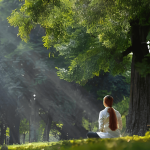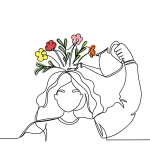Art has always been a powerful form of expression, and when it comes to dealing with anxiety, it can be a transformative tool. This article explores the journey from chaos to canvas, offering tips for using art as a means of emotional expression and therapeutic release.
The Creator’s Personal Approach
Art, in its various forms, becomes a sanctuary during times of anxiety. The creator shares a personal approach to making art, providing a unique perspective on how the creative process can be a form of self-art therapy. Viewers are not merely observers but are invited to participate actively, engaging in their own creative endeavors.
Art as a Tool for Understanding Anxiety
Beyond the strokes and colors, art serves a purpose in understanding and addressing anxiety. It becomes a language for emotions, allowing individuals to connect with their inner selves. This section delves into how art can facilitate a deeper understanding of emotions, the practice of compassion, and the release of tension.
Recommended Materials
To embark on this artistic journey, minimal materials are required. Recommending paper, sketchbooks, oil pastels, colored pencils, a notebook, and a pen, the article underscores the simplicity of the process. It emphasizes that art therapy doesn’t require elaborate tools; rather, the focus is on the act of creation itself.
Mindfulness Integration
Before dipping into the artistic process, mindfulness plays a crucial role. The article advocates for a brief mindfulness exercise, focusing on breathing to center attention. By incorporating mindfulness, individuals can enhance their awareness, making the art session a more intentional and calming experience.
Visualization Technique
The article introduces a visualization technique where anxiety is envisioned as shapes, lines, and colors. This mental imagery is then translated onto the canvas or paper. Emphasizing that there’s no right or wrong way to depict anxiety allows for a free-flowing and uninhibited creative process.
Reflective Writing Component
Art doesn’t end with the strokes; it extends to reflective writing. After completing their artwork, participants are encouraged to engage in reflective writing in a journal. The article provides prompts, guiding individuals to reflect on visual aspects, the messages conveyed, and potential improvements for a more soothing effect.
Creating a No Judgment Zone
An essential aspect of therapeutic art is creating a space without judgment. Participants are reminded of the importance of focusing on the creative process itself, devoid of criticism. Sharing experiences in the comments section fosters a supportive community, reinforcing the idea that each artistic expression is valid and meaningful.
Engaging in a Therapeutic Art Session
With all the tools and techniques in hand, the article concludes by encouraging readers to actively engage in a therapeutic art session. It’s an invitation to explore and express anxiety creatively, using simple materials and reflective writing to enhance the overall experience.
Conclusion
In the chaos of anxiety, the canvas becomes a sanctuary. Art therapy offers a unique journey of self-discovery, compassion, and release. By embracing the creative process, individuals can transform their emotional turmoil into a masterpiece, finding solace and expression in every stroke.
FAQs
- Is artistic talent necessary for therapeutic art sessions?
- No, therapeutic art sessions focus on the process rather than the outcome, making it accessible to everyone, regardless of artistic skill.
- Can children participate in art therapy for anxiety?
- Absolutely, art therapy is a versatile tool suitable for individuals of all ages, including children.
- How often should one engage in therapeutic art sessions?
- The frequency varies, but consistency is key. Engaging in sessions regularly can contribute to long-term emotional well-being.
- What if I don’t have all the recommended materials?
- Improvise with what you have. The essence of art therapy lies in the act of creation, not the tools.
- Can therapeutic art replace professional therapy for anxiety?
- While art therapy can be a valuable complement, it’s essential to consult with a mental health professional for comprehensive support.









